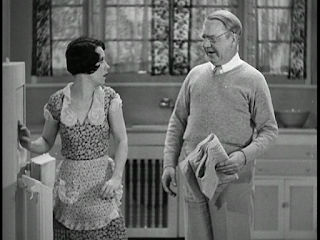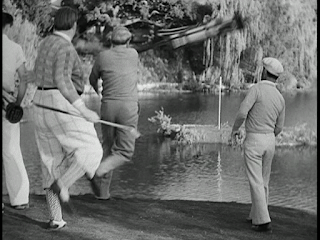Jean-Luc Godard's satirical black comedy Weekend (1967) is a film that at its core is comprised of two elements one would expect to be diametrically opposed. On the one hand, it's a wickedly funny film, one that has a bright, vivid color palette and a freewheeling, madcap sense of energy. On the other hand, it's a very dark film: it covers subject matter that's quite morbid and features imagery that suggests graphic violence, and its musical score creates a sinister, menacing atmosphere. It's this commingling of elements that gives the film its distinct identity- that is, as one that's both very dark and extremely funny.
Its fundamental subject is societal disintegration and breakdown, one covered the next year in George Romero's Night of the Living Dead (1968). It was made during a time of great upheaval for much of the world: America was experiencing great civil unrest, and in the year following Weekend's release France would be racked by the student uprisings of May 1968.
The plot involves a middle-class couple (Jean Yanne and Mireille Darc) making a weekend trip to her father's house so they can make sure he wills them a large inheritance before his impending death. However, they accidentally crash their car on the way there, and have to walk and hitch rides the rest of the way. The film's plot is a loose, freewheeling one, in which what happens to the couple and what they encounter along the way is more important than the story per se.
Godard's version of '60's France is a heightened, exaggerated one, in which car crashes seemingly happen every five minutes and the countryside is littered with wrecked cars. The couple encounter a number of colorful people along the way, from a man who can perform magic (or at least play with the laws of cinematic reality) to figures from history and literature. As they make it farther and farther on their journey society descends further and further into chaos around them, with them walking past burning cars and bloody corpses.
The couple are truly beastly, abominable people, and serve as representations of what Godard loathes and despises. They plan to kill the wife's mother if she doesn't give them what they want, and unbeknownst to each other have been planning to kill the other one with the help of their lovers. Their behavior is aggressive and belligerent from the get-go, and they become more and more violent as the film goes on. When a woman demands that they exchange insurance information after the husband backs into her car, they start a fight with her. When a man in a phone booth is taking too long to finish a conversation, they harass him until he hangs up. While driving they force cars, pedestrians, and bicycles off the road. When they encounter Emily Bronte, they burn her alive when she goes off on a philosophical tangent.
They're hardly the only terrible people in the film. When a tractor driver hits a young couple's sports car and kills the man, his girlfriend screams at him, saying that he deserved to live because he was young, rich, and handsome. (On a side note, I think it's absolutely hilarious to see the tractor driver singing the "Internationale": it's certainly not the kind of thing you'd see in America.)
While most of what I've described makes the film sound quite dark and grisly, Godard makes the proceedings feel fun and lively, as well as humorous. Some of the funniest scenes are those which reflect Godard's Marxist politics. When the husband tries to hitch a ride a passing motorist asks him whether he'd rather be screwed by Johnson or Mao, and when he responds Johnson she angrily drives off. When he asks one of a pair of truck drivers he and his wife hitch a ride from for some of his sandwich, he gives him a tiny piece and says that it represents the amount of U.S. foreign aid given to the Congo. When the wife asks the other one for some of his, he forces her to kiss him and then slaps her when she takes the piece he offers her. When she reacts with outrage, he responds that he's only emulating the behavior of Western oil companies toward Algeria.
Godard also has fun with the film, and there are certain scenes where he seems to be deliberately messing with the viewer. When the wife discusses a sexual encounter with a previous lover with her current one, the music is so loud that it's often hard to hear what she's saying. (This is a case where an English-speaking viewer watching the film with subtitles would have an advantage over a native French speaker.) In one scene one of the truck drivers eats a sandwich and stares at the camera while the other goes off on a long-winded political tangent offscreen, and when he finishes it's the other man's turn to do the same while he goes off on an extended tangent of his own.
Godard also includes a lot of colorful dialogue in the film. When the couple drive off following the confrontation with the woman whose car they backed into, her son yells at the husband, "Bastard! Shit-heap! Communist!" When the young woman screams at the tractor driver, she yells, "You impotent bunch are incapable of screwing!"
Godard uses interesting cinematic devices in a few scenes. One scene consists of several minutes of Godard panning past a massive traffic jam caused by a car crash up the road, which the couple of course impatiently try to make their way around. (This scene features incessant honking by impatient motorists, and the more patient ones play cards and throw balls to each other.) One scene features a rotating shot of a barnyard as a man plays the piano, and the camera does quite a number of revolutions.
Godard also gleefully plays with cinematic reality and the onscreen image. A mysterious "miracle man" who forces the couple to pick him up at gunpoint causes a flock of sheep to suddenly materialize via a jump cut. When the couple's car crashes, Godard doesn't show it directly but splits and fractures the image, making it look like the projector's messing up.
Godard is also known for using the distancing device of having his characters acknowledge that they're in a film and even address the audience at times, which was also used by Tex Avery. At one point the husband tells his wife that they're in a "rotten film" where "all we meet are crazy people." When they kill Emily Bronte the husband says that she's only a fictional character, and the wife remarks that they are as well. When a passing motorists asks the husband whether he's in real life or a film, he responds that he's in a film. (Godard's distancing devices also make the film's violence easier to take: since its characters are two-dimensional and he acknowledges that they don't actually exist, the viewer doesn't have an emotional reaction to the couple's horrible mistreatment of those around them or the horrors eventually inflicted on them.)
Godard is known for being a passionate cinephile, someone who truly loves the medium of film, and that's on dispaly in this film. When communicating via two-way radios, the revolutionaries in the latter portion of the film use code names derived from some of Godard's favorite films. The choice of films reflects not just cinephilia but a truly worldwide cinephilia: namechecked are not just American films like Johnny Guitar (1954) and The Searchers (1956) but European ones like The Saga of Gosta Berling (1924) and Battleship Potemkin (1925).
As I've alluded to earlier, Godard eventually gives the couple their comeuppance and they suffer a horrible fate of their own. After they kill the wife's mother they're kidnapped by a gang of revolutionaries, who kill the husband. This is the point where the film's descent into chaos reaches it peak, and it arrives at its darkest and most violent point. When the wife and one of the revolutionaries look down at the bloody corpse of a murdered man, he says that "the horror of the bourgeoisie can only be overcome with more horror," which is a truly chilling statement. (It's clear that despite his radical politics Godard doesn't sympathetic with them, and finds them as dark and frightening as the viewer.) Godard also includes (unsimulated) scenes of a pig and chicken being killed during this portion of the film, to serve as a shock to the viewer's senses. However, these dark, violent elements are counterbalanced by sillier and, more lighthearted ones, like a woman being raped with a fish (too outlandish to be taken seriously) and one of the revolutionaries playing the drums in the middle of a forest clearing.
The film ends on a great gag. While the wife is eating some pork one of the revolutionaries tells her that some meat from her husband is mixed in with it. She shrugs it off and continues eating it, which is a fitting reaction for her: given the behavior we've seen her display throughout the film, one wouldn't expect anything else.































